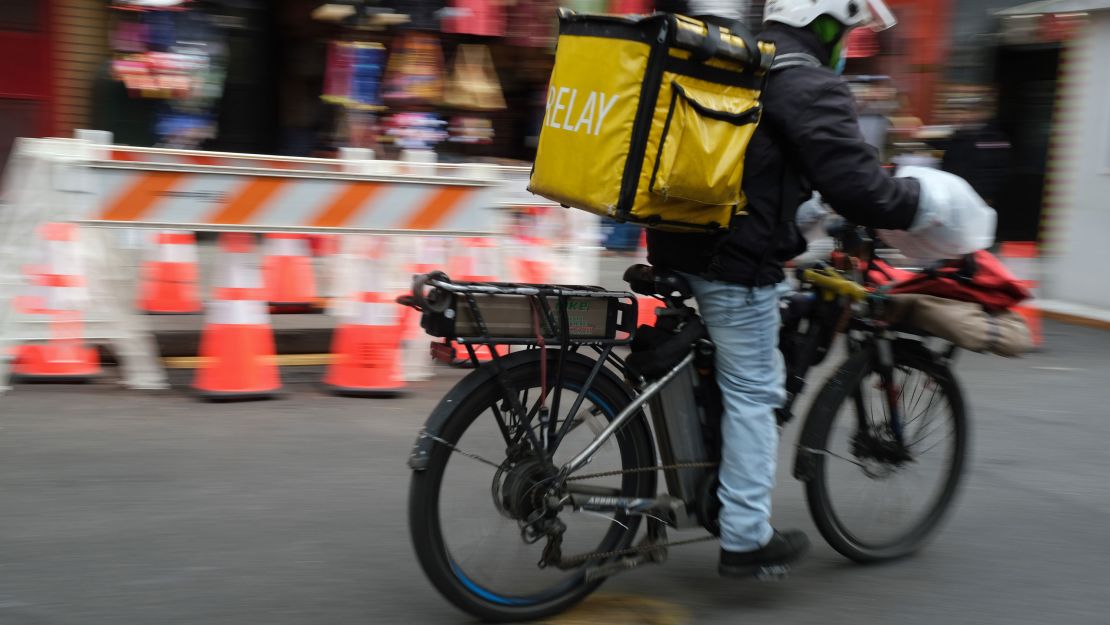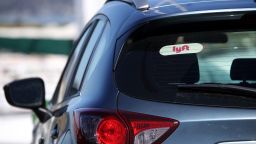Accidents on sidewalks and intersections. Dangerously congested bike paths. Delivery workers with nowhere to pee. Exploding electric bikes and scooters.
New York City is known for fast meals and easy access to everything, but its public spaces are being severely strained by the surge in on-demand deliveries, fueled by a pandemic boom in online orders and the rise of a new crop of ultra-fast delivery services.
There are around 65,000 delivery workers on Uber Eats, DoorDash, Postmates and other apps who bike around the city’s five boroughs every day, pushing to bring impatient customers their meals as quickly as possible.
But even the largest city in the country isn’t designed to handle the rise of online ordering and the influx of delivery workers.

The lack of infrastructure for food delivery has created a new set of challenges for workers, pedestrians, residents and public officials. Lawmakers are taking action, with more bike lanes, new rules around bathroom access and an ongoing campaign to combat the risk of lithium-ion fires in electric bikes and scooters. But so far, it’s not been enough to keep up with the rapid growth.
The city’s struggle to address these issues touches on a number of flash points, including the makeup of scarce public space, the rise of gig work, NIMBYism, safety concerns and the future of urban transportation.
The way New York City handles these issues will shape the response in other major cities.
“It’s an intersection of competing problems that no one place has authority over,” said Andrew Wolf, a research fellow at the Workplace Justice Lab at Rutgers University who studies the gig economy. “It’s a workers’ rights issue, but it’s also a transportation issue. And are the companies going to take more responsibility?”
‘Shifting the burden to workers and the public’
On-demand delivery workers, who are primarily low-income immigrants, are typically classified as independent contractors rather than employees of the apps or restaurants.
The industry has been criticized for that freelance model as it means companies are not obligated to provide these workers with benefits such as overtime and paid sick leave. But it also means the companies are not required to ensure bathroom or rest stop access, provide charging stations for electric bikes, or provide bikes at all.
The independent contractor model has left gaps in worker conditions, researchers and worker advocates say. Now, the city may be paying the price.
“Before, when the workers worked for restaurants, they supplied bikes, bathrooms and rest areas,” Wolf said. “Now, companies have adopted the independent contractor model where they shift the burden to workers and the public.”
Delivery app companies have opposed changes to this business model that would make them responsible for employing workers and providing them with a minimum wage and other benefits. This would increase their costs and could make it harder for them to stay in business, as many big name services have never turned a consistent profit. Companies, meanwhile, say their platforms offer flexible earning opportunities for workers that allow them to set their own schedules.
That has left city officials to largely figure it out on their own.
New York City has built more than 1,500 miles of bike lanes as it promotes different forms of transportation, but they are still clogged up with commuters and delivery workers, and accidents are frequent.
An analysis by The City, a local news organization, found that complaints about cycling, scootering and even in-line skating occurring in unwanted locations have boomed from pre-pandemic levels. The bike lanes also are not designed for e-bikes racing at fast speeds.
The city, which ranks 93rd in the nation when it comes to bathrooms per capita, with fewer than 1,200 public restrooms for its 8.5 million residents, has also taken some steps to address the shortage for couriers. But the progress has been limited, too.
Lack of bathroom access
Joshua Wood, a courier for Uber Eats and DoorDash, often sits outside restaurants on the curb while he waits — unpaid — for an order, or seeks cover under scaffolding when it rains.
When he needs to go to the bathroom, he says he sometimes gets turned away from restaurants, despite a local law passed in 2022 requiring them to give access to couriers if they pick up orders.
“People view delivery workers as dirty, smelly and taking up too much space,” said Wood, a member of Workers Justice Project, an advocacy group for delivery workers in New York City. “They want us to be this invisible army that gets what they need done. They don’t want to pay attention to how the sausage gets made.”
The most basic need delivery workers lack is bathroom access in restaurants or in public spaces, according to a 2021 report by the Workers’ Justice Project and The Worker Institute of Cornell University. The report included a survey of 500 app-based couriers doing deliveries in NYC, focus groups of workers, and individual interviews. Most of those surveyed reported that they have been denied bathroom use at restaurants.
There’s been some movement to provide bathrooms and rest stops for delivery workers.
New York City last year announced a $1 million investment to create hubs for delivery workers, turning empty spaces like vacant newsstands into rest areas and e-bike charging stations.
But there has been opposition in some neighborhoods to the development of these hubs that has stalled their expansion. One New York City neighborhood voted against a proposed site.
In February, Chick-fil-A opened a single temporary “Brake Room” for workers to stop by, open eight hours a day, six days a week. The pit stop had outlets where workers could charge their phones, couches, chairs and tables, and an indoor bike dock — although it banned e-bikes.
The rest stop closed in April.
E-bikes
There is also the growing challenge of electric bikes.
An estimated 80% of delivery workers rely on e-bikes and motorbikes, according to Ligia Guallpa, director of the Workers Justice Project, an advocacy group. The growing dependency on e-bikes has been driven by demands on delivery workers, including faster delivery and bigger areas to cover.
But there is a shortage of safe charging and storage infrastructure for e-bikes.
Some of these bikes, powered by lithium-ion batteries, have caught fire when charging and caused deadly explosions. New York City has seen more than 63 fires and five deaths caused by lithium-ion batteries in 2023 so far. Fires related to lithium-ion batteries caused a total of six deaths in all of 2022.
Online marketplaces, which some delivery workers may have turned to for more affordable options in the absence of company-provided options or subsidies, often make it hard to tell the origin of these products and the quality of their batteries.
“E-bike fires are happening because of the lack of charging and parking stations and the lack of education” about e-bike safety, Guallpa said. “There is a shared responsibility from city government, corporations and consumers to ensure workers do this in a safe way.”
New York City Mayor Eric Adams’ administration has announced initiatives here, including efforts to promote safe battery use and pilot programs for e-bike charging in parks, but it has echoed Guallpa’s point that the problem can only be fixed if the public and private sector work together.
“This is a broad responsibility,” Meera Joshi, the city’s deputy mayor for operations, in March. “Agency partners, delivery apps, and labor partners must work together to ensure that this equipment critical to delivery worker’s livelihood does not take lives instead.”
Some private companies are stepping up. Uber is funding a new program that aims to get electric bikes with non-certified lithium-ion batteries off New York City streets.
The company said in April it will soon give the thousands of New York City delivery workers who use e-bikes the ability to trade-in their bikes for newer, safer models.
Workers Justice Project has called for more to be done. The organization wants a “safety surcharge” fee on delivery orders for customers that would go toward funding bikes as well as charging and parking stations, and education campaigns around e-bike safety.
Divya Subramanian, an associate director at NYU’s Center for Sustainable Business, supports a surcharge and, incentives to lower the cost of high-quality e-bikes, and more charging stations.
“This is the kind of infrastructure we need for all citizens,” she said. “But delivery workers are on the front lines of this and it’s even more necessary for them.”
CNN’s Samantha Kelly and Danielle Wiener-Bronner contributed to this article.











